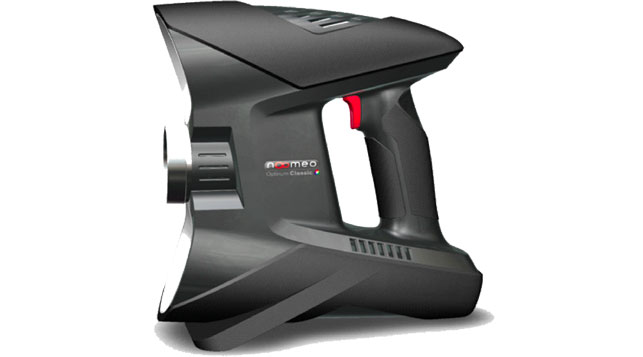The laser scanning world is highly active at the moment with a steady stream of new products coming on-line. Stephen Holmes looks at the OptiNum from French manufacturer, Noomeo, which offers a new take on the technology
The 3D laser scanning market is changing. Handheld scanners are becoming increasingly popular, not least for their ability to capture 3D forms in a fraction of the time of more traditional devices.
Noomeo’s OptiNum is one of a new breed of devices to hit the market. It’s different to other handheld laser scanners insofar as it doesn’t require the user to place laser targets on the item to be scanned. It is this ease of use that is sure to make it an attractive proposition for non-expert engineers and designers.

Noomeo’s OptiNum uses a combination of white light and video to generate its point cloud data
The scanner is suitable for a wide range of industries, including general reverse engineering and modelling, the mechanical, medical and prosthetics sectors, and even for simple digital archiving of components.
The OptiNum is not a laser scanner, per se. Instead it uses digital image processing technology, a combination of white light and video from its high-definition CCD cameras, to generate its point cloud data.
One of the major strengths of the OptiNum is that it is a lightweight device. At 2kg, it’s lighter than most laptops, making it easy to transport and manoeuvre. However, while it is powered by an in-built battery, it still needs to be connected to a laptop via a USB connection during operation. It would be great to see a wireless version in the future – anyone that has tripped over a laptop power cable will know exactly why.

Using the OptiNum to reverse engineer a mould
The real beauty of the OptiNum is that it is so quick to get up and running. There is no need for the traditional dots, targets or other means of spatial positioning – everything is done automatically without the end user having to waste time preparing the model. According to Noomeo, it uses complex algorithms to position itself in relation to the subject and boasts an accuracy of up to +/- 100μm. While this means it cannot capture as fine a detail as most competitive handheld scanners, it still means it is suitable for many reverse engineering applications.
The recommended volume for scanned objects is from 10cm3 to 1m3. This puts it at the lower end of the scale for handheld scanners, however Noomeo also says the device’s flexibility means it can be used to scan inside larger parts such as aircraft wings, between complex pipeworks, or at the top of high structures.
The scanner comes with an acquisition software application called NumiSoft. This enables simple clean up of the point cloud, automatic meshing and export to ASCII, XYZ, DXF, and STL formats. An optional software tool, NumiSoft +, offers additional functionality including point cloud and mesh import capabilities, and mesh modification, editing and clean up tools and OBJ export.
As a tool for reverse engineering a product or part with speed and ease, the OptiNum is an exciting proposition
Conclusion
The Noomeo OptiNum is an exciting new entrant to the handheld 3D scanning market. It’s incredibly easy to operate, requires little to no setup time, and can be used pretty much anywhere due to its portability. What’s more it only costs €25,000, putting it within reach of many design and engineering firms.
Of course, at this price there have to be some tradeoffs and it should be clear that this is an entry-level device. Accuracy is at the bottom end of the scale for handheld scanners, but as a tool for reverse engineering a product or part with speed and ease, the OptiNum is an exciting proposition.
OptiNum
Noomeo
€25,000
Stephen Holmes looks at OptiNum from Noomeo, which offers a new take on laser scanning
No
http://www.noomeo.com






